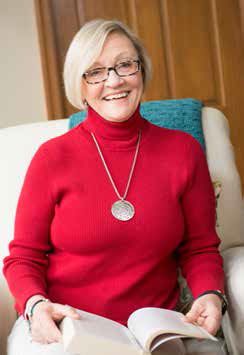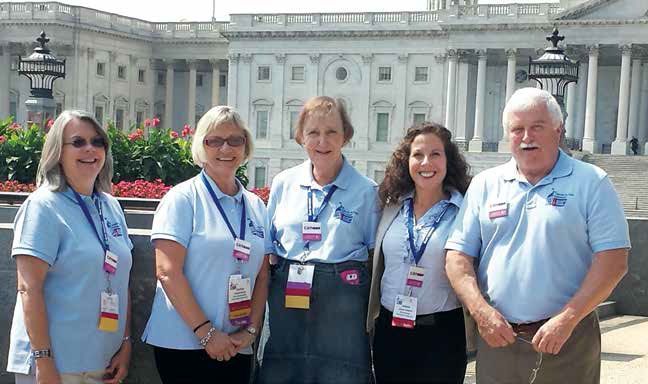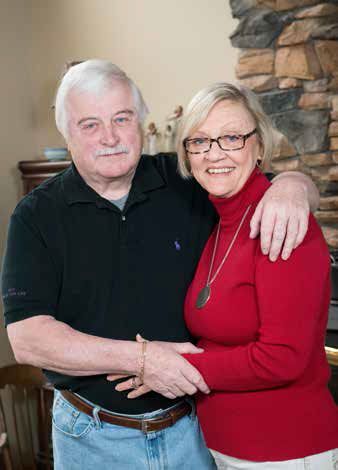Out in the Lobby
Millions in the cancer community are working to increase research funding or change policy.
George Ann Blough did not become an advocate for cancer policy the first time her ovarian cancer went into remission. It was only when the cancer returned that she vowed to donate some portion of the time she had left to the war against cancer.
She proved so effective at raising funds through the American Cancer Society’s (ACS’s) Relay for Life events that leadership reached out and asked her to get involved with its advocacy efforts. It took three tries, but the group finally recruited her as part of its Cancer Action Network (CAN), and she has risen since then to become its top volunteer in West Virginia.
PHOTO BY BRANDON BOGER

After a recurrence of ovarian cancer, George Ann Blough became an advocate for changes to government health policy.
“I hesitated at first because I didn’t think there was any way that a person like me would be able to influence government policy,” Blough says.
“I was an average person, not a power broker, but I realized that my experience gave me the power to influence during one of the first big events I attended. I was speaking on a panel with a university president and the head of the National Institutes of Health, and after we had all finished speaking the reporters pushed past them to interview me.”
Advocacy At All Levels
Blough felt further empowered by the training she received from ACS CAN, training that teaches volunteers the art of advocacy, one step at a time. She has since used those skills on U.S. senators, county health boards and nearly every type of government official in between. Her efforts helped convince her local board of health to ban workplace smoking, and they helped persuade the West Virginia state legislature to ban the use of tanning beds by children under 14.Countless decisions at every level of government — decisions about where people can smoke, what health insurers must cover, which medications are approved and how much money will go to fund research — ultimately affect cancer incidence, cancer mortality and the quality of life before, during and after cancer for the millions of individuals affected by the disease.
Influencing those decisions, therefore, ranks among the principal objectives of all advocates in the cancer arena, from major organizations like the ACS to individual lobbyists like Blough.
Measured by financial outlays, advocacy on behalf of the cancer community constitutes a relatively small lobby. The largest of these advocacy groups spent only about $4 million on such activities in 2013. Measured by manpower, however, cancer-community advocates rank among the most powerful of all lobbies. ACS CAN has just a few hundred paid employees but more than a million volunteers, including Blough. Organizations devoted to combatting particular types of cancer have millions more at the ready to make phone calls, send emails, write letters, raise funds, recruit additional volunteers, inform the public and lobby legislators from the local level up.
These unpaid armies once lobbied independently and sometimes undermined each other, either by contributing to competition for funding between different cancer communities or simply by making inconsistent requests. Today, 48 of the largest cancer advocacy groups concentrate most of their lobbying efforts under a single banner, One Voice Against Cancer (OVAC), which combines resources to fight for common goals.
“In areas that are budget-driven, we’re treading water. We’ve held our own during the years of sequester, and we’re looking to build on that going forward,” says Dick Woodruff, vice president of federal relations at ACS CAN, which, in turn, manages day-today operations at OVAC. “But there are still plenty of opportunities on the legislative front, even when money is tight. At the state and local levels, we’ve had some success in raising tobacco taxes, and those higher prices will reduce the number of teenagers who take up smoking.
PHOTO COURTESY OF GEORGE ANN BLOUGH

George Ann Blough, second from left, gathers with fellow advocates in Washington, D.C.
Funding Cancer Research
“At the federal level, we got a bill passed that directs the FDA to expedite the approval of sunscreens that have been available in Europe for years,” Woodruff continues. “This may sound like a minor victory, but 13,000 people die of melanoma each year, almost entirely because of sun exposure, and these sunscreens work much better than older ones.”Last year, the research budget of the National Cancer Institute (NCI) was just under $5 billion. On paper, excluding two special supplements, the agency’s budget has held relatively steady in recent years, which means it hasn’t kept pace with inflation. Stated in constant 1999 dollars, NCI expenditures have fallen from a peak of around $4 billion in 2003 to roughly $3 billion today.
OVAC members hope the strengthening economy and the bipartisan support for medical research will allow them to turn the tide this year. The group is asking Congress to increase the NCI’s budget by 6.9 percent.
Advocates for cancer patients would naturally like more, particularly given the widespread perception that genetic targeting and immunotherapy are ready to bear incredible fruit, but money is still tight, and lobbyists deal in the art of the possible.
As always, the OVAC request says nothing about how much should go to each cancer. Groups that wish to join the cooperative must agree to work together on maximizing the total research budget and letting the NCI choose the most productive uses for it.
Still, organizations that belong to OVAC have been known to lobby Congress for direct earmarks when they see opportunity. The Recalcitrant Cancer Research Act targets all cancers that kill more than half of their victims within five years, including lung cancer, but the Pancreatic Cancer Action Network pushed it through Congress, so it focuses largely on issues important to the pancreatic cancer community, and led to the NCI, in 2013, laying out recommendations for action on four new pancreatic cancer research initiatives.
The group celebrated the law’s passage with a press release that said the act “was the culmination of five years of effort by the Pancreatic Cancer Action Network’s passionate advocates and volunteers—who sent 76,000 emails, made 14,000 calls to Congress and participated in 1,500 meetings.” Groups that focus on particular cancers also try to influence the NCI’s decisions by building relationships with agency staffers—a practice that leads some to believe cancers with weak lobbies get shortchanged.
Jonathan Agin, for example, says the agency spends far too little on pediatric cancer research.
Agin has devoted much of his life to the battle against pediatric cancers since 2008, when his 2-year-old daughter, Alexis, was diagnosed with a diffuse intrinsic pontine glioma. She survived only 33 months.
Agin and his wife created National Race Against the Odds to raise funds for pediatric cancer research, an effort that generated more than $350,000 in its first five years. Agin has also lobbied both Congress and the NIH for research money.
“The NCI’s position is that although it only spends 4 percent of its research budget specifically on pediatric cancer, research into other types of cancer should benefit children who develop such cancers,” Agin says. “But that trickle-down effect really hasn’t happened so far. Childhood cancer is not just adult cancer in a smaller person. It acts differently, often more aggressively, because every muscle, every organ, every system inside a child’s body is undergoing constant growth.”
Making Legislative Change
“It would make more sense,” Agin says, “to develop treatments for children and let them trickle up to adults, an idea that achieved major success in the ’50s and ’60s.”Agin has made such arguments to countless legislators and bureaucrats, but he believes they have failed to sway the NCI, so these days he devotes most of his energy to other initiatives.
This strategy recently produced a significant victory in a surprising area, the fight against identity theft. Many families that have lost children to cancer — Agin’s among them — have also become victims to thieves who use vacated Social Security numbers for tax fraud. In collaboration with U.S. Representative Sam Johnson, Agin helped pass a bill last year aimed at keeping retired Social Security numbers private by stripping them from federal death lists.
PHOTO BY BRANDON BOGER

One of Blough’s most important jobs is recruiting new volunteers, and one of her best finds is her husband, Brooke, who now coordinates volunteer activities throughout their county.
Agin is currently the general counsel and development liaison for the Children’s Cancer Therapy Development Institute and the director of external affairs for the Max Cure Foundation.
“Right now, drug companies have strong incentives to exclude children. Biological differences between children and adults might skew trial results and jeopardize approvals. A child might suffer some terrible side effect and make national news,” Agin says. “Unfortunately, adults-only trials produce adults-only approvals for virtually all new cancer drugs.”
Although some new drugs have been approved recently for the treatment of pediatric cancers, Agin says, “Children often still receive the same treatments they got 30 years ago and have no access to medications that might work better. We need to give drug companies the ability to sign children up for trials without penalizing them if the medications don’t work on children.”
A legislative victory for advocates in the cancer community, no matter what their individual interests, was the passage of the Affordable Care Act. The new law includes a number of features that ACS CAN has long advocated, especially the safeguards that help people with pre-existing conditions to get affordable insurance coverage for both standard treatments and clinical trial care.
With that victory won, ACS CAN is starting a major push to increase palliative care, a term that’s often associated solely with end-of-life pain management but actually encompasses a wide range of coordinated medical support services from psychotherapy to physical therapy.
ACS CAN has already lent its support to three palliative care bills that have been introduced in Congress. Those bills appear unlikely to pass this term, but the group will keep working to build support.
An Exhaustive Effort
“We think it’s a big opportunity for everyone, and we plan to push on both the legislative front and within government agencies that can encourage palliative care by doing things like creating payment codes for (medical discussions) that happen over the phone or over the Internet rather than face to face,” says Woodruff, of ACS CAN.Advocates for those with cancer, be they one-man operations like Agin or million-man operations like ACS CAN, represent just a fraction of the many special interests that try to influence federal health care policy. Other groups lobby on behalf of doctors, hospitals, insurers, employers and many other constituencies.
The expenditures of these other lobbies dwarf those of cancer policy advocates. Indeed, the pharmaceutical industry spent nearly $230 million on its lobbying efforts in 2013 alone. The insurance industry spent more than $150 million, hospitals more than $90 million and health care professionals more than $85 million.
The agendas of a given group may align with those of the cancer lobby on issues such as research funding, yet clash over others -- for instance, how many costs payers should pass on to patients.
The sheer number of players and issues make it hard to generalize about allies and opponents. Organizations that agree on some points are almost certain to disagree on others.
While volunteers within the cancer community may have different individual missions, too, they tend to have one thing in common: They work tirelessly. They present their cases as many times as they can, in as many ways as they can, in as many venues as they can. It is a labor-intensive operation, but the enormous supply of volunteers makes it possible.
ACS CAN makes an annual show of its support by bringing hundreds of survivors, family members and volunteers to Washington each September for Lobby Day. Supporters from virtually every congressional district flood the Capitol in matching blue shirts for meetings with hundreds of elected officials.
Such events draw national attention, but the vast majority of cancer-policy advocacy plays out in a series of smaller, less visible efforts — like the work Blough did to help convince the West Virginia state legislature to ban access to tanning beds to children under 14.
She considers that a victory, but says she won’t stop pushing for safeguards until the age limit is raised even higher.
To be in sync with some other states that have banned children from using tanning beds, “We wanted the age limit to be 18, but it’s a start, and we’ll keep on trying,” says Blough, who believes in the power of persistence. “We didn’t win the first time we tried to get our board of health to ban workplace smoking. We told them that we’d keep coming back ’til we got the votes, and we did.”
One of Blough’s most important jobs is recruiting new volunteers, and one of her best finds is her husband, Brooke, who now coordinates volunteer activities throughout their county.
“I figured that the only way I’d ever see much of her was to sign up for the organization,” he joked. “Actually, it’s one of the best decisions I’ve ever made. We have seen so many positive developments in the last few years, some that make the news but many that never do, and it’s very rewarding to be a part of that.”
